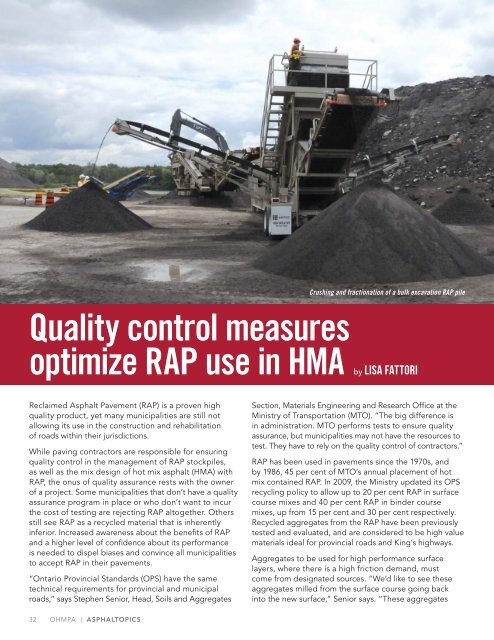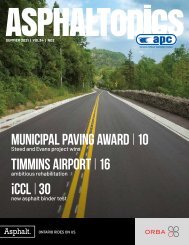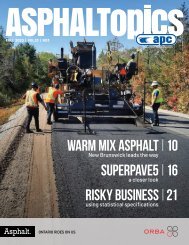ASPHALTopics | Spring 2014 | VOL 27 | NO 1
You also want an ePaper? Increase the reach of your titles
YUMPU automatically turns print PDFs into web optimized ePapers that Google loves.
Crushing and fractionation of a bulk excavation RAP pile<br />
Quality control measures<br />
optimize RAP use in HMA<br />
by Lisa Fattori<br />
Reclaimed Asphalt Pavement (RAP) is a proven high<br />
quality product, yet many municipalities are still not<br />
allowing its use in the construction and rehabilitation<br />
of roads within their jurisdictions.<br />
While paving contractors are responsible for ensuring<br />
quality control in the management of RAP stockpiles,<br />
as well as the mix design of hot mix asphalt (HMA) with<br />
RAP, the onus of quality assurance rests with the owner<br />
of a project. Some municipalities that don’t have a quality<br />
assurance program in place or who don’t want to incur<br />
the cost of testing are rejecting RAP altogether. Others<br />
still see RAP as a recycled material that is inherently<br />
inferior. Increased awareness about the benefits of RAP<br />
and a higher level of confidence about its performance<br />
is needed to dispel biases and convince all municipalities<br />
to accept RAP in their pavements.<br />
“Ontario Provincial Standards (OPS) have the same<br />
technical requirements for provincial and municipal<br />
roads,” says Stephen Senior, Head, Soils and Aggregates<br />
Section, Materials Engineering and Research Office at the<br />
Ministry of Transportation (MTO). “The big difference is<br />
in administration. MTO performs tests to ensure quality<br />
assurance, but municipalities may not have the resources to<br />
test. They have to rely on the quality control of contractors.”<br />
RAP has been used in pavements since the 1970s, and<br />
by 1986, 45 per cent of MTO’s annual placement of hot<br />
mix contained RAP. In 2009, the Ministry updated its OPS<br />
recycling policy to allow up to 20 per cent RAP in surface<br />
course mixes and 40 per cent RAP in binder course<br />
mixes, up from 15 per cent and 30 per cent respectively.<br />
Recycled aggregates from the RAP have been previously<br />
tested and evaluated, and are considered to be high value<br />
materials ideal for provincial roads and King’s highways.<br />
Aggregates to be used for high performance surface<br />
layers, where there is a high friction demand, must<br />
come from designated sources. “We’d like to see these<br />
aggregates milled from the surface course going back<br />
into the new surface,” Senior says. “These aggregates<br />
32 OHMPA | ASPHALTOPICS


















